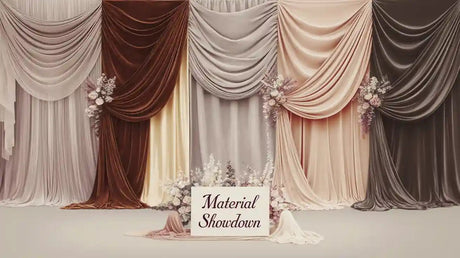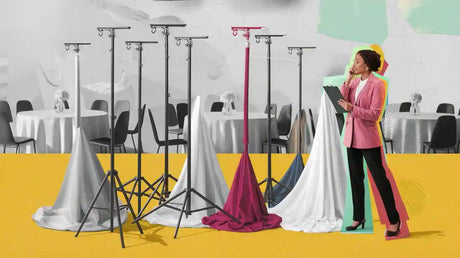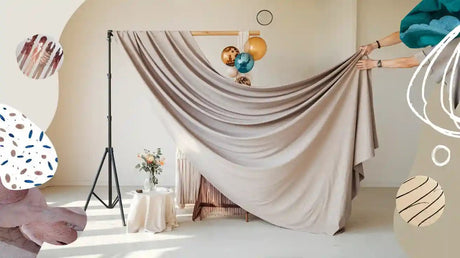
When figuring out how much fabric you need to cover a chair, the answer depends on a few factors. A standard wingback chair might take 5-7 yards, while larger ones could need 8-10 yards. If you're using bold patterns, plan for 20% more fabric to cover those tricky repeats and alignments.
Key Takeaways
Get tools like a tape measure, notebook, and fabric calculator. Good tools help you measure correctly.
Measure each chair part one by one. Add extra fabric for seams and designs. This avoids running out of fabric.
Think about the chair type when guessing fabric needed. Different chairs need different fabric amounts. Check guides for each chair type.
Tools and Preparation for Measuring Fabric to Cover a Chair
Essential Tools for Measuring
Before measuring, gather the tools you’ll need. The right tools make the job easier and more accurate. Here’s what to have:
Measuring Tape: A bendable tape works best for curved parts like arms.
Notebook and Pen: Write down measurements so you don’t forget them.
Straight Edge or Ruler: Helps measure flat chair areas.
Fabric Calculator: Online tools can turn measurements into fabric amounts.
Chalk or Fabric Marker: Mark spots on the chair or fabric for guidance.
Using good tools makes your measurements more precise. For instance, studies show that better tools reduce mistakes when measuring fabric. This proves why quality equipment is worth it.
Preparing the Chair for Accurate Measurements
Getting the chair ready is important for correct measurements. First, remove cushions or decorations from the chair. This gives you a clear surface to measure. Then, check the chair for curves or seams that might change your measurements.
Follow these steps to measure properly:
Start with the back. Measure from the top to the seat cushion.
Next, measure the seat’s width and depth.
Measure the arms. Check their length and width.
Don’t forget the wings. Measure from the top of each wing to the seat.
Lastly, measure the whole chair. Get its height, width, and depth.
Skipping seam allowances or pattern matching can cause problems. The Upholstery and Fabric Association says 35% of DIY projects fail due to bad measurements. Taking your time now can save trouble later.
Step-by-Step Guide to Estimate Upholstery Fabric Yardage
Measuring Chair Cushions
Start by measuring the cushions, as they often require the most fabric. Use a flexible measuring tape to measure the length and width of each cushion from seam to seam. Add an extra inch to each measurement for seam allowances. For seat cushions, you’ll typically need 1 to 1.5 yards of fabric, while back cushions may require 0.5 to 1 yard.
Don’t forget to account for fabric that tucks into crevices or wraps around the edges. This ensures a snug fit and a polished look. If your chair has multiple cushions, measure each one individually and sum up the yardage. This step helps you avoid running out of fabric mid-project.
Measuring the Chair Frame
Next, measure the frame of the chair. Start with the back, noting its height and width. Then, measure the arms, seat, and front rail beneath the cushions. Add an inch to each measurement for seams. If your chair has wings, include an additional 0.5 to 1 yard of fabric for each wing.
Once you’ve measured all parts, convert the measurements into yards by dividing the total inches by 36. Remember to consider the fabric’s width, which usually ranges from 45 to 60 inches. This affects how much fabric you’ll need to cover the entire frame.
Accounting for Seams and Fabric Overlaps
Seams and overlaps are easy to overlook but crucial for a professional finish. Add at least an inch to every measurement to account for seams. If your fabric has a pattern, you’ll need extra yardage to align the design across seams. For bold patterns, plan for 20% more fabric.
Mistakes happen, especially if you’re new to upholstery. Add 10-15% extra fabric to your total yardage for errors or future repairs. This small buffer can save you from frustration later.
Tip: Always double-check your measurements before purchasing fabric. It’s better to have a little extra than to run short!
How to Calculate Fabric Yardage for a Chair
Turning Measurements into Fabric Yardage
After measuring your chair, calculate how much fabric you need. Add the length and width of each part you measured. For example, if the back is 40 inches tall and 20 inches wide, multiply them to get 800 square inches. Repeat this for all chair sections.
Then, divide the total square inches by 36 to find yards. This gives you an estimate of the fabric required. Check the fabric’s width, which is usually 45 to 60 inches. Wider fabric might mean you need fewer yards.
Tip: Fabrics with patterns or designs may need extra fabric to match properly.
Adjusting for Patterns and Repeats
If your fabric has a pattern, plan for repeats. Patterns like stripes or flowers need careful matching, which uses more fabric. Add 15-25% extra fabric for this. For bold or large patterns, use the higher percentage.
Fabrics like velvet or corduroy need all pieces cut the same way. This keeps the look consistent. Add another 15-20% to your total for these fabrics.
Adding Extra Fabric for Errors or Repairs
Mistakes can happen, especially if you’re new to this. Add 10-15% more fabric as a backup. This extra fabric is also useful for future fixes or touch-ups.
It’s smart to buy more fabric than you think you’ll need. Fabric colors can vary between batches, so having extra ensures it matches. Running out of fabric during your project can be stressful, but a little extra can save you trouble.
Note: If you’re unsure about your math, ask an upholstery expert for help.
Chair-Specific Guidelines for How Much Fabric You Need
Dining Chairs
Dining chairs are one of the easiest types to reupholster, making them a great starting point for beginners. For each chair, you’ll need about 3/4 to 1 yard of fabric. If you’re working on a set of six chairs, plan for 4.5 to 6 yards in total.
Here’s a quick breakdown:
Seat-only reupholstery: 3/4 yard per chair.
Seat and backrest: 1 yard per chair.
Dining chairs are typically reupholstered every 7-10 years, so it’s worth investing in durable fabric. If you’re using patterned fabric, add 20% more to ensure proper alignment.
Tip: Always measure each chair individually. Slight variations in size can affect how much fabric you need.
Wing Chairs
Wing chairs are a bit more complex due to their unique shape. A standard wingback chair usually requires 5-7 yards of fabric, while oversized ones may need 8-10 yards.
Chair Size |
Fabric Yardage (54″ wide) |
|---|---|
Small |
5-6 yards |
Medium |
6-7 yards |
Large |
7-8 yards |
Oversized |
8-10 yards |
When measuring, don’t forget to account for the wings, arms, and cushions. Each wing typically needs an extra 0.5-1 yard, while the arms require 0.5-0.75 yards each. For cushions, allow 1-1.5 yards for the seat and 0.5-1 yard for the back.
Note: Wing chairs with intricate designs or tufting may need additional fabric.
Club Chairs
Club chairs are versatile and come in various styles, which can affect fabric requirements. On average, you’ll need 5-7 yards of fabric for a standard club chair. Larger or more detailed designs may require up to 10 yards.
Fabric Width |
Average Yardage |
|---|---|
54 inches |
6-8 yards |
60 inches |
5-7 yards |
The chair’s dimensions play a big role in determining how much fabric you’ll need. Always measure the height, width, and depth of the chair, and don’t forget to include extra yardage for seams and overlaps.
Tip: If you’re unsure how to estimate fabric yardage for a club chair, consult an upholstery expert or use an online fabric calculator.
Tips for Picking the Best Fabric for a Chair
Knowing Fabric Widths
Fabric width affects how much you’ll need. Most upholstery fabrics are 45 or 54 inches wide. Wider fabric can mean using less material, especially for big chairs. Measure your chair and think about fabric width to avoid buying too much or too little.
If your fabric has patterns, matching designs at seams needs extra material. Big patterns might need up to 25% more fabric than plain or small prints. This is key for bold designs where mismatched seams are noticeable.
Tip: Check fabric width before buying. It helps you get the right amount and avoid surprises.
Picking Patterns and Colors
Fabric patterns and colors can change how your chair looks. Natural fabrics like cotton and linen are comfy and classic. For something stronger, try synthetic blends or velvet. These fabrics look fancy and last longer.
Think about your room’s style when choosing patterns. Stripes and shapes feel modern, while flowers and plain colors are timeless. Many people now like eco-friendly fabrics, such as organic cotton or recycled materials.
Pro Tip: Pick colors that match your room and hide stains if the chair will be used a lot.
Buying Extra Fabric for Later
It’s a good idea to buy extra fabric. Patterns often need more material to match repeats, sometimes adding up to 25%. Details like piping or tufting can also need 10-15% more fabric.
Extra fabric is helpful for repairs or touch-ups later. Fabric colors can vary between batches, so buying more now keeps everything matching if you reupholster.
Reminder: Spending a little more on extra fabric now can save trouble later.
Measuring and calculating fabric yardage doesn’t have to feel overwhelming. Remember these steps:
Measure each chair section carefully.
Add extra yardage for seams, patterns, and repairs.
Consider the chair type and fabric width.
Fabrics with patterns or naps need extra care. Experts suggest adding 15-20% more fabric for these. If you’re unsure, consulting a professional can save time and effort. With practice, you’ll get better and more confident. So, grab your tools and start your project today!
FAQ
How do I know if I’ve measured my chair correctly?
Double-check your measurements. Compare them to the chair’s actual dimensions. If they match, you’re good to go! Mistakes? Re-measure to ensure accuracy.
Can I use leftover fabric from another project?
Yes, but check the fabric’s width and pattern. Make sure it’s enough to cover your chair. Leftovers work best for small chairs or cushions.
What’s the best fabric for beginners?
Start with cotton or polyester blends. They’re durable, easy to work with, and affordable. Avoid stretchy or slippery fabrics until you’re more experienced.
Tip: Always test a small piece of fabric on your chair before committing to the full project!








